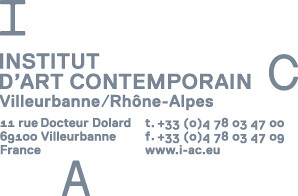Charwei Tsai
Jef Geys
June 2–August 13, 2017
La Fête, La Musique, La Noce (Fun, Music and Festivities) were, in fact, all euphemisms, in the colourful slang of Napoleon’s grand army, for “war”—La Guerre.
The three words are the battle cry of Maria Loboda’s one-woman show at the IAC, her biggest ever in France. But, lurking under this slightly baroque exhibition title with its blithe overtones of jollity and merriment, there is a sense of menace. An underlying tension sets in early and stays with the visitor until the end of the exhibition.
More interested in the imperfections and meanderings of history than she is in the archaeological evidence for it or in its legitimate functions, Maria Loboda bases her work on the interpretation and re-appropriation of rituals and, by extension, the symbols specific to different communities.
Through a transhistorical reading of myths, the occult and the arcane and alchemical sciences, the artist summons up iconic forms that interrogate the significance or the obsolescence of artefacts invented by man in the face of forces far greater than he. Nothing lasts forever and nothing is ever quite as it appears. Although Loboda’s works abound in pretence and false likenesses, and any attempt at chronological or spatial linearity is thwarted by their aesthetics, they gradually reveal their hidden depth as you look at them.
Our system of recognition is constantly undermined; the profusion of contradictory, all too human, signs throws us further off balance. Whatever the eye alights on, whatever it recognizes, is immediately countered by a dissident element, a voluptuous story that twists or distorts the first narrative. We can’t be sure of anything; the fragments of a Gallo-Roman bas-relief are shorn of the logic that we first attributed to them when we discover the curves of warriors and sealed water bottles (The Wealth Of Neolithic Elites, 2017). From titles full of promise (To Separate the Sacred From the Profane, 2016; Tout terriblement, 2017) to the last gasp of In the Long Yawn, 2016, the words have the power to hide more than they reveal. Maria Loboda offers elliptical and enigmatic narratives that disturb the visitor. Her coded installations arouse suspicions through judicious encryption, and the key to the code is language.
For this exhibition, the Institute has changed the way it looks: openings have been enlarged, the walls and ceilings are vaulted, the style oscillates between the sacred on one hand (chapel, pyramid or that symmetry peculiar to temples—somewhere between the antechamber and the inner shrine) and, on the other hand, the domesticity of, for example, the corridor, the bourgeois interior, the studio or the boudoir. In La Fête, La Musique, la Noce various stage sets are presented as if for different scenes in a play, with the artworks as characters in the plot. A violence lurks just below the alluring surface. An alarm signal is about to sound; the curtain is going up. On the stage there is a scalding cup.
For its summer program, along with Maria Loboda’s show, the Institut d’art contemporain Villeurbanne/ Rhône-Alpes also presents two other solo exhibitions: Water Moon by the Taiwan-born artist, Charwei Tsai, as well as two projects, Le Tour de France 1969 d’Eddy Merckx et Les Plantes Médicinales by belgian artist Jef Geys.
Curators:
For Maria Loboda, La Fête, La Musique, la Noce: Nathalie Ergino and Magalie Meunier
For Charwei Tsai, Water Moon: Nathalie Ergino and Magalie Meunier
For Jef Geys:
Le Tour de France 1969 d’Eddy Merckx: Sylvie Boulanger & Francis Mary
Coproduction: cneai, Chatou; CAPC musée d’art contemporain de Bordeaux; Les Bains-Douches, Alençon; Centre d’art contemporain / Passages, Troyes; Institut d’art contemporain, Villeurbanne/Rhône-Alpes
Les Plantes Médicinales: Nathalie Ergino

